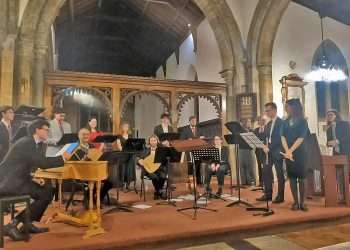As far as the dots on the page go, William Byrd’s gorgeous Mass for five voices is relatively easy – there’s nothing particularly difficult in the rhythms or harmony, and the lines almost sing themselves, which probably explains why the alto part has lodged itself immovably in my brain. The mass was composed not for public performance in a cathedral, but for private use by recusant catholic families, celebrating Mass in secret in each other’s houses, so Byrd probably had to keep things fairly simple so that it could be sung by whoever was on hand.
The notes may be easy, but what really takes work and effort is creating a sense of line, keeping the five parts neatly defined so that Byrd’s polyphony doesn’t just come over as a mush. We work on this sort of thing a lot in our regular choir practices, but last weekend we were given the treat of spending a day working on the mass, and the motet Ne irascaris Domine, with Robert Hollingworth, musical director of I Fagiolini, a regular on Radio 3, and an expert on renaissance vocal music. He’s also, we discovered, a man who can casually demonstrate all the modal scales – I was very impressed.
The two things we really worked on were the placing of consonants and tuning. We’re often told to make sure that we put consonants in early, but I hadn’t really thought about the mechanics of exactly where to put them until Robert’s explanation at the workshop. It’s probably obvious, but it had passed me by that the idea is to make sure that the vowels come in on the beat with the consonant tucked in before, and Robert had us reciting silly sentences in mock-Italian accents, as the speech rhythms of Italian make the point abundantly clear.
The harder idea to grasp, initially, was what Robert had to say about tuning. I’m aware of all the complications of early tuning, and have a rough grasp of the physics involved but beyond that, it gets a bit alarming. Basically, the 12 semitones of our modern scale are derived from a mathematical fudge to simplify the ratios between notes, and before the world of Western music settled on that particular fudge, other fudges were in place. If I’ve understood it correctly, Byrd’s music relies more on tuning derived from natural harmonic overtones – if you play or sing a note, it’s not one pure soundwave, but several simultaneous waves – the first of which is a fifth above the original note, then an octave, and at some point a third kicks in that is in fact just a smidgeon lower than our major third. I found it hard actually to hear, but by doing what Robert told us, and listening very carefully to the basses behind me, I could feel how the chords fitted a little better – and the thirds he played on the piano afterwards did sound rough in comparison. The converse was to sing minor thirds very bright – I couldn’t follow how this fitted mathematically, but again it worked and felt good. Singing major thirds slightly low goes against everything we’ve ever been told, but we stayed very nicely in tune. It reminded me abut an extremely good book that I read a few years ago – The Music Instinct, by Philip Ball, which discusses how music works and how we hear it and process it, and it contained a good overview of how we arrived at modern tuning. When I first read it, I knew it was a book I’d have to re-read at some point to reinforce my understanding so I think the time for that has come.
Robert had kindly come to Durham at very short notice to replace Andrew Carwood, and several times he said that one of the first things Andrew Carwood would have said was that the most important thing when singing Byrd, more than any historical niceties is to really mean what you’re singing. This is the sort of thing that I agree with wholeheartedly and a couple of little points jumped out from the mass that I hadn’t noticed before. We hadn’t yet done much work on the Credo, so I think I can be forgiven for only just spotting the force behind the music for “et unum sanctam catholicam et aposoticam Ecclesiam” ([I believe] in one holy catholic and apostolic church) when the voices easy out of the polyphony to a dramatic statement. A similar moment occurs at the third and final statement of “Agnus Dei” – sudden glorious but heartbreaking chords, and until Robert mentioned it I hadn’t made the connection with the Agnus Dei being sung at communion, that key point of doctrinal difference between Byrd and his Protestant persecutors.
It may sound from this as if it was a terribly serious day, but thanks to Robert’s energy and humour (my pre-workshop homework really should have been to watch Monty Python not frantically swot Byrd notes) it was lots of fun and I will forgive him for his inaccurate jibe about altos. Shameless concert plug – we’re sing the Byrd on 21 June – details via the link below. Come along and hear the result.








